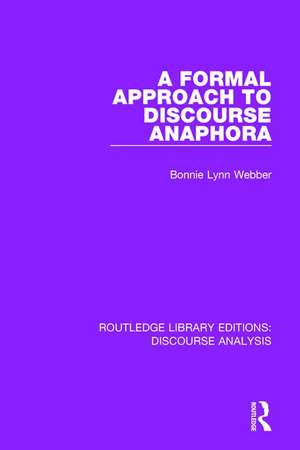A Formal Approach to Discourse Anaphora: RLE: Discourse Analysis
Editat de Bonnie Lynn Webberen Limba Engleză Paperback – 17 mai 2018
| Toate formatele și edițiile | Preț | Express |
|---|---|---|
| Paperback (1) | 371.57 lei 43-57 zile | |
| Taylor & Francis – 17 mai 2018 | 371.57 lei 43-57 zile | |
| Hardback (1) | 764.20 lei 43-57 zile | |
| Taylor & Francis – 2 noi 2016 | 764.20 lei 43-57 zile |
Din seria RLE: Discourse Analysis
-
 Preț: 358.35 lei
Preț: 358.35 lei -
 Preț: 358.35 lei
Preț: 358.35 lei -
 Preț: 318.44 lei
Preț: 318.44 lei -
 Preț: 318.62 lei
Preț: 318.62 lei - 34%
 Preț: 3492.06 lei
Preț: 3492.06 lei -
 Preț: 369.63 lei
Preț: 369.63 lei -
 Preț: 238.04 lei
Preț: 238.04 lei -
 Preț: 318.23 lei
Preț: 318.23 lei -
 Preț: 316.50 lei
Preț: 316.50 lei
Preț: 371.57 lei
Nou
Puncte Express: 557
Preț estimativ în valută:
71.10€ • 74.43$ • 58.83£
71.10€ • 74.43$ • 58.83£
Carte tipărită la comandă
Livrare economică 07-21 aprilie
Preluare comenzi: 021 569.72.76
Specificații
ISBN-13: 9781138224056
ISBN-10: 1138224057
Pagini: 204
Dimensiuni: 156 x 234 x 11 mm
Greutate: 0.34 kg
Ediția:1
Editura: Taylor & Francis
Colecția Routledge
Seria RLE: Discourse Analysis
Locul publicării:Oxford, United Kingdom
ISBN-10: 1138224057
Pagini: 204
Dimensiuni: 156 x 234 x 11 mm
Greutate: 0.34 kg
Ediția:1
Editura: Taylor & Francis
Colecția Routledge
Seria RLE: Discourse Analysis
Locul publicării:Oxford, United Kingdom
Cuprins
Acknowledgements; Table of Contents; Synopsis; Chapter 1. Introduction; 1. Statement of the Problem 2. The Range of Discourse Anaphora 3. Historical Background 3.1 Factors Influencing Anaphor Resolution 3.1.1 Number/gender agreement 3.1.2 Backwards Anaphora constraint 3.1.3 Theme 3.1.4 Role Inertia 3.1.5 Semantic Sectional Restrictions 3.1.6 Recency and Scene Shifts 3.1.7 Implicit Causality 3.1.8 Possible Words 3.2 Methods of Simplifying Anaphor Resolution 3.3. Previous Research on Verb Phrase Ellipsis 4. The Range of Antecedents and Referents 4.1 Individuals 4.2 Sets 4.3 Stuff 4.4 Generics 4.5 Prototypes 4.6 Actions, Events, States, Prepositions 4.7 Descriptions 4.8 Predicates 5. Fundamental Assumptions 6. Thesis Organisation; Chapter 2. Definite Pronouns; 1. Introduction 1.1 The Notion of a Discourse Model 1.2 The Importance of Descriptions 1.3 Warnings to the Reader 1.4 Chapter Organisation 2. Factors in forming Discourse Entity IDs 2.1 Noun Phrase Specificity 2.1.1 The Definite/Indefinite Distinction 2.1.2 The Referential/Attributive Distinction 2.1.3 The Specific/Non-specific Distinction 2.1.4 Non-standard Determiners 2.2 Member/Set Information 2.3 Three Uses of Plurals 2.4 Pronouns in the Input 2.5 Alternative Perspectives 2.6 Embedded Noun Phrases 3. Representational Conventions 3.1 Noun Phrases in General 3.2 Singular Noun Phrases 3.3 Plural Noun Phrases 4. Preliminary Rule for Deriving Discourse Entity IDs 4.1 Informal Examples 4.2 Independent Quantifiers and Definite Descriptions 4.3 Dependent Quantifiers and Definite Descriptions 4.3.1 For each… there exists 4.3.2 Class Restriction Dependencies 4.3.3 Quantifiers in class Restrictions 5. Other Factors in Deriving Descriptions 5.1 Tense 5.2 Conditionals 5.3 Disjunction 5.4 Negation 6. Discourse Models and Anaphor Resolution 7. Summary; Chapter 3. "One Anaphora"; 1. Introduction 2. Requirements on a Representation 2.1 Preserving Noun Phrases as Structural Units 2.2 Further Factoring of Descriptions 2.3 Disambiguating Word Senses 2.4 Resolving Definite Pronouns 3. Possible Representations 3.1 Syntactic Surface Structure 3.2 Level-2 Interpretations 4. Identifying Candidate Antecedents 5. Representatives of ‘One’-Anaphora 5.1 That and Those 5.2 O 5.3 It 6. Non-explicit Descriptions 7. Summary; Chapter 4: Verb Phrases Ellipsis; 1. Introduction 1.1 Historical Context 1.2 Chapter Organisation 2. System Requirements: Representational & Procedural 2.1 Surface Subjects 2.2 Pronouns 2.3 Existential Quantifiers 2.4 Negation 25 Plurals 2.6 Non-subject Relative Clauses 3. Surface Constraints on Verb Phrases Ellipsis 3.1 Proximity 3.2 Structural Position 3.3 Voice Constraints 3.4 Negation 3.5 Tense and Aspect 4. Resolving Verb Phrase Ellipsis 5. Inference and Verb Phrase Ellipsis 5.1 Conjoined Predicates and ‘Headless’ relatives 5.2 Split Reciprocals 5.3 Embedded Descriptions 6. Summary; Chapter 5. Conclusion; 1. Summary 2. Future Research 2.1 Data-driven and expectation-driven Processes in Model Synthesis 2.2 Reference Requirements in Limited Contexts 2.3 Sententially-evoked Discourse Entities 3. Epilogue; Bibliography
Descriere
First published in 1979, the author argues there is an intimate connection between formal sentential analysis and the synthesis of an appropriate conceptual model of the discourse. Some of the issues with the creation of this conceptual model are discussed in the second chapter, which follows a background to the thesis. The third and fourth chapters examine two types of anaphoric expression that do not refer to non-linguistic entities. The final chapter details three areas into which this research could potentially be extended. This book will be of interest to students of linguistics.
